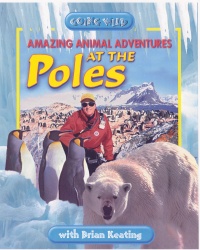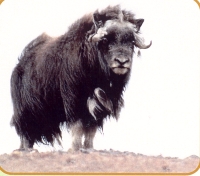| ________________
CM . . .
. Volume XI Number 15 . . . .April 1, 2005
excerpt:
Second in the "Going Wild" series, Keating's book, Amazing Animal Adventures at the Poles takes the reader on fascinating naturalist journeys to the top and bottom of the world. Following a brief introduction with background information on Keating's career choice, the book is laid out in ten chapters that focus on animal species the author has encountered during a number of different trips to the polar regions. Within each four page chapter, the reader will find excellent photos taken by Keating and his wife. Captions, inserts titled "Brian's Notes" and several sidebars offer additional information to extend the text. Each chapter includes a text box, Say the Word!, which defines new or challenging vocabulary. These components are attractively arranged on varying coloured backgrounds, sometimes with text overlaid on a full page photograph. An activity has been included—Build Your Own Plant Press. It is presented as part of the introduction and may seem at odds with the focus of the title, Animal Adventures. Its use is explained in more detail on page 22 where Keating examines plant life that is a vital part of the whole High Arctic ecosystem and describes adaptations that allow particular species to survive in the severe climate. The conversational writing style is entertaining to read. Vivid description stirs the imagination: "...this island...came out of the mist, a white dog's tooth of fluted near-vertical ice slopes." The six Arctic and four Antarctic adventures are packed with intriguing facts and personal observations, such as finding "qiviut, the underwool of the muskox" where the animals had rubbed against rocks, and collecting enough for yarn to make scarves. The reader is made to feel 'right there' along with the adventurers on their excursions by land and sea. While some species overlap from a couple of chapters in the first book, eg. walrus and penguins, the details are fresh in this book.
These samples of life in extreme locations on the planet will give young readers a starting point to further investigations about the animals and their habitats. This book makes a good companion to the first in the series. Highly Recommended. Gillian Richardson is a freelance writer and former teacher-librarian who lives in BC.
To comment
on this title or this review, send mail to cm@umanitoba.ca.
Copyright © the Manitoba Library Association. Reproduction for personal
use is permitted only if this copyright notice is maintained. Any
other reproduction is prohibited without permission.
NEXT REVIEW |
TABLE OF CONTENTS FOR THIS ISSUE
- April 1, 2005.
AUTHORS |
TITLES |
MEDIA REVIEWS |
PROFILES |
BACK ISSUES |
SEARCH |
CMARCHIVE |
HOME |

 In contrast to the high energy opening chapter in the first book, Chapter 1 this time is a slower introduction. The Arctic species mentioned are seen mainly in the distance—no face to face, life and death excitement to hook the reader—and the final page of this chapter takes an introspective turn in a more adult voice. As well, the phrase, "we figured we would pull a Farley Mowat and simply pretend we were part of their group" [Arctic hares] might leave young readers puzzled. Chapter headings themselves are less graphic, with some giving the reader little clue as to the content, eg. Getting to it All, and Wandering South. After the first three chapters deal with Arctic locations, the visits to either pole alternate through the rest of the book. Overall, it creates a choppy feel and may challenge a reader to keep track of where the animal species are found. Elementary age children frequently consider penguins as an Arctic species.
In contrast to the high energy opening chapter in the first book, Chapter 1 this time is a slower introduction. The Arctic species mentioned are seen mainly in the distance—no face to face, life and death excitement to hook the reader—and the final page of this chapter takes an introspective turn in a more adult voice. As well, the phrase, "we figured we would pull a Farley Mowat and simply pretend we were part of their group" [Arctic hares] might leave young readers puzzled. Chapter headings themselves are less graphic, with some giving the reader little clue as to the content, eg. Getting to it All, and Wandering South. After the first three chapters deal with Arctic locations, the visits to either pole alternate through the rest of the book. Overall, it creates a choppy feel and may challenge a reader to keep track of where the animal species are found. Elementary age children frequently consider penguins as an Arctic species.